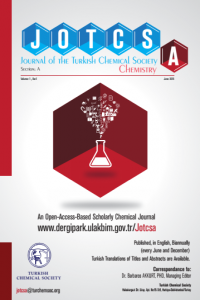Abstract
Electrochemical decolorization of textile dyeing wastewater containing Reactive Violet 5 (RV5) were investigated at Pt/Ir electrodes in the presence of 75%NaCl+25%Na2CO3 (w/w) supporting electrolyte mixture in a batch electrochemical reactor. Experimental parameters were operated in the range of 300-1500 mg/L textile dye concentration, 4-20 g/L 75%NaCl+25%Na2CO3 electrolyte concentration, 5-15 mA/cm2 current density, and 20-60°C reaction temperature in 15 min electrolysis time. Reactive Violet 5 decolorization increased with increasing current density and electrolyte concentration, and decreasing the textile dye concentration. Although a slight increase obtained in color removal efficiency, the temperature was not show much significant effect on decolorization. Depending on electrochemical reaction conditions, Reactive Violet 5 textile dye decolorization were obtained between 42.8-100%.
References
- Körbahti BK, Tanyolaç A. Electrochemical treatment of simulated textile wastewater with industrial components and Levafix Blue CA reactive dye: Optimization through response surface methodology. Journal of Hazardous Materials. 2008;151(2-3):422–31. DOI: 10.1016/j.jhazmat.2007.06.010.
- US EPA. EPA Office of Compliance Sector Notebook Project : Profile of the Textile Industry. 1997. EPA310R97009.
- US EPA. Best Management Practices for Pollution Prevention in the Textile Industry. 1996. EPA625R96004.
- Körbahti BK. Response surface optimization of electrochemical treatment of textile dye wastewater. Journal of Hazardous Materials. 2007;145(1-2):277–86. DOI: 10.1016/j.jhazmat.2006.11.031.
- Brillas E, Martínez-Huitle CA. Decontamination of wastewaters containing synthetic organic dyes by electrochemical methods. An updated review. Applied Catalysis B: Environmental. 2015. p. 603–43. DOI: 10.1016/j.apcatb.2014.11.016.
- Comninellis C, Chen G. Electrochemistry for the environment. Springer; 2010. ISBN: 9780387369228.
- Körbahti BK, Artut K. Electrochemical oil/water demulsification and purification of bilge water using Pt/Ir electrodes. Desalination. 2010;258(1-3):219–28. DOI: 10.1016/j.desal.2010.03.008.
- Körbahti BK, Taşyürek S. Electrochemical oxidation of ampicillin antibiotic at boron-doped diamond electrodes and process optimization using response surface methodology. Environmental Science and Pollution Research. 2015;22(5):3265–78. DOI: 10.1007/s11356-014-3101-7.
- Panizza M, Cerisola G. Direct And Mediated Anodic Oxidation of Organic Pollutants. Chemical Reviews. 2009;109(12):6541–69. DOI: 10.1021/cr9001319.
- Tarr MA. Chemical Degradation Methods for Wastes and Pollutants. CRC Press; 2003. ISBN: 9780824743079.
- Rajeshwar K, Ibanez JG. Environmental Electrochemistry. Academic Press; 1997. ISBN: 9780123887320.
- Vlyssides AG, Israilides CJ, Loizidou M, Karvouni G, Mourafeti V. Electrochemical treatment of vinasse from beet molasses. Water Science and Technology. 1997;36(2-3):271–8. DOI: 10.1016/S0273-1223(97)00398-3.
- Israilides C, Vlyssides A, Mourafeti V, Karvouni G. Olive oil wastewater treatment with the use of an electrolysis system. Bioresource Technology. 1997;61(2):163–70. DOI: 10.1016/S0960-8524(97)00023-0.
- Do J-S, Yeh W-C. Paired electrooxidative degradation of phenol with in situ electrogenerated hydrogen peroxide and hypochlorite. Journal of Applied Electrochemistry. 1996;26(6):673–8. DOI: 10.1007/BF00253467.
- Lin SH, Shyu CT, Sun MC. Saline wastewater treatment by electrochemical method. Water Research. 1998;32(4):1059–66. DOI: 10.1016/S0043-1354(97)00327-8.
- Tchobanoglous G, Burton FL, Stensel HD. Wastewater Engineering: Treatment and Reuse. McGraw-Hill, 2004. ISBN: 9780071241403.
- Shen ZM, Wu D, Yang J, Yuan T, Wang WH, Jia JP. Methods to improve electrochemical treatment effect of dye wastewater. Journal of Hazardous Materials. 2006;131(1-3):90–7. DOI: 10.1016/j.jhazmat.2005.09.010.
Abstract
References
- Körbahti BK, Tanyolaç A. Electrochemical treatment of simulated textile wastewater with industrial components and Levafix Blue CA reactive dye: Optimization through response surface methodology. Journal of Hazardous Materials. 2008;151(2-3):422–31. DOI: 10.1016/j.jhazmat.2007.06.010.
- US EPA. EPA Office of Compliance Sector Notebook Project : Profile of the Textile Industry. 1997. EPA310R97009.
- US EPA. Best Management Practices for Pollution Prevention in the Textile Industry. 1996. EPA625R96004.
- Körbahti BK. Response surface optimization of electrochemical treatment of textile dye wastewater. Journal of Hazardous Materials. 2007;145(1-2):277–86. DOI: 10.1016/j.jhazmat.2006.11.031.
- Brillas E, Martínez-Huitle CA. Decontamination of wastewaters containing synthetic organic dyes by electrochemical methods. An updated review. Applied Catalysis B: Environmental. 2015. p. 603–43. DOI: 10.1016/j.apcatb.2014.11.016.
- Comninellis C, Chen G. Electrochemistry for the environment. Springer; 2010. ISBN: 9780387369228.
- Körbahti BK, Artut K. Electrochemical oil/water demulsification and purification of bilge water using Pt/Ir electrodes. Desalination. 2010;258(1-3):219–28. DOI: 10.1016/j.desal.2010.03.008.
- Körbahti BK, Taşyürek S. Electrochemical oxidation of ampicillin antibiotic at boron-doped diamond electrodes and process optimization using response surface methodology. Environmental Science and Pollution Research. 2015;22(5):3265–78. DOI: 10.1007/s11356-014-3101-7.
- Panizza M, Cerisola G. Direct And Mediated Anodic Oxidation of Organic Pollutants. Chemical Reviews. 2009;109(12):6541–69. DOI: 10.1021/cr9001319.
- Tarr MA. Chemical Degradation Methods for Wastes and Pollutants. CRC Press; 2003. ISBN: 9780824743079.
- Rajeshwar K, Ibanez JG. Environmental Electrochemistry. Academic Press; 1997. ISBN: 9780123887320.
- Vlyssides AG, Israilides CJ, Loizidou M, Karvouni G, Mourafeti V. Electrochemical treatment of vinasse from beet molasses. Water Science and Technology. 1997;36(2-3):271–8. DOI: 10.1016/S0273-1223(97)00398-3.
- Israilides C, Vlyssides A, Mourafeti V, Karvouni G. Olive oil wastewater treatment with the use of an electrolysis system. Bioresource Technology. 1997;61(2):163–70. DOI: 10.1016/S0960-8524(97)00023-0.
- Do J-S, Yeh W-C. Paired electrooxidative degradation of phenol with in situ electrogenerated hydrogen peroxide and hypochlorite. Journal of Applied Electrochemistry. 1996;26(6):673–8. DOI: 10.1007/BF00253467.
- Lin SH, Shyu CT, Sun MC. Saline wastewater treatment by electrochemical method. Water Research. 1998;32(4):1059–66. DOI: 10.1016/S0043-1354(97)00327-8.
- Tchobanoglous G, Burton FL, Stensel HD. Wastewater Engineering: Treatment and Reuse. McGraw-Hill, 2004. ISBN: 9780071241403.
- Shen ZM, Wu D, Yang J, Yuan T, Wang WH, Jia JP. Methods to improve electrochemical treatment effect of dye wastewater. Journal of Hazardous Materials. 2006;131(1-3):90–7. DOI: 10.1016/j.jhazmat.2005.09.010.
Details
| Journal Section | Articles |
|---|---|
| Authors | |
| Publication Date | January 8, 2017 |
| Submission Date | June 29, 2016 |
| Published in Issue | Year 2016 Volume: 3 Issue: 3 |



